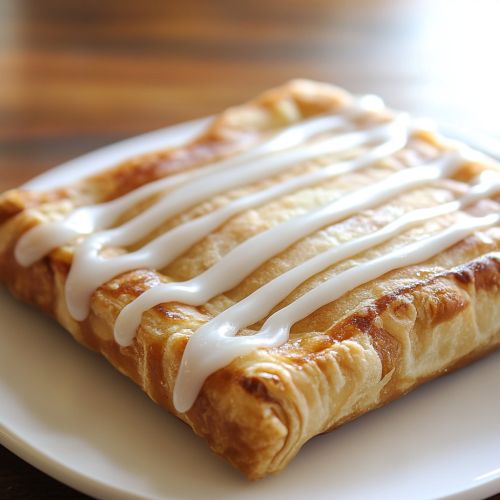Toaster Strudel
Introduction
Toaster Strudel is a brand of toaster pastry that has become a staple in many households across North America. Introduced by Pillsbury in the 1980s, Toaster Strudel offers a convenient, quick breakfast option that combines a flaky pastry exterior with a sweet filling. This article delves into the history, production, varieties, nutritional aspects, and cultural impact of Toaster Strudel, providing a comprehensive understanding of this popular food product.
History
The inception of Toaster Strudel can be traced back to the early 1980s when Pillsbury sought to compete with the already popular Pop-Tarts. The idea was to create a product that offered a more pastry-like experience, akin to a traditional strudel, but with the convenience of a toaster pastry. The initial launch was met with positive consumer response, leading to a rapid expansion of flavors and distribution.
Development and Launch
The development of Toaster Strudel involved extensive research and testing to perfect the balance between the pastry and filling. Pillsbury's innovation lay in its unique dough formulation, which allowed the pastry to maintain its flakiness even after being heated in a toaster. The first Toaster Strudel hit the market in 1985, featuring a simple apple flavor.
Market Expansion
Following its successful launch, Pillsbury expanded the Toaster Strudel line to include a variety of flavors such as strawberry, blueberry, and raspberry. The brand capitalized on the growing trend of convenience foods, positioning itself as a premium alternative to other toaster pastries. By the 1990s, Toaster Strudel had become a household name, synonymous with quick and easy breakfasts.
Production Process
The production of Toaster Strudel involves several key stages, each critical to ensuring the quality and consistency of the final product. The process begins with the preparation of the dough, followed by the incorporation of the filling, and finally, the packaging.
Dough Preparation
The dough used in Toaster Strudel is a laminated dough, similar to that used in croissants and puff pastries. This involves layering butter between sheets of dough, which is then folded and rolled multiple times to create a flaky texture. The dough is then cut into the desired shape and size before moving to the next stage.
Filling and Assembly
Once the dough is prepared, it is filled with a variety of sweet fillings. These fillings are typically fruit-based, although other options such as cream cheese and chocolate have been introduced over time. The filled pastries are then sealed and crimped to prevent leakage during the toasting process.
Packaging and Distribution
After assembly, the Toaster Strudels are flash-frozen to preserve freshness and extend shelf life. They are then packaged in boxes that include individual icing packets, allowing consumers to add a personal touch to their pastries. The frozen pastries are distributed to grocery stores and supermarkets, where they are sold in the frozen foods section.
Varieties
Toaster Strudel offers a wide range of flavors to cater to diverse consumer preferences. These flavors can be broadly categorized into fruit, dessert, and seasonal varieties.
Fruit Flavors
Fruit flavors are the cornerstone of the Toaster Strudel lineup, with options such as apple, strawberry, blueberry, and raspberry. These flavors are made using fruit purees and are designed to provide a balance of sweetness and tartness.
Dessert Flavors
In addition to fruit flavors, Toaster Strudel has introduced dessert-inspired options such as cinnamon roll, chocolate, and cream cheese. These flavors aim to replicate the taste of popular desserts in a convenient toaster pastry format.
Seasonal and Limited Editions
Toaster Strudel occasionally releases seasonal and limited-edition flavors to capitalize on holiday themes and consumer trends. Examples include pumpkin spice during the fall and peppermint during the winter holiday season.
Nutritional Information
Understanding the nutritional profile of Toaster Strudel is important for consumers who are mindful of their dietary intake. Each serving of Toaster Strudel provides a combination of carbohydrates, fats, and sugars, with variations depending on the flavor.
Caloric Content
A typical serving of Toaster Strudel contains approximately 180-200 calories, with the majority of these calories coming from carbohydrates and fats. The icing packet adds additional calories, primarily from sugar.
Macronutrients
Toaster Strudel is composed of approximately 25-30 grams of carbohydrates, 8-10 grams of fat, and 2-3 grams of protein per serving. The pastry is not a significant source of dietary fiber or protein, making it a less balanced breakfast option compared to whole foods.
Micronutrients and Additives
While Toaster Strudel does contain some vitamins and minerals, such as iron and calcium, these are often added during the manufacturing process rather than being naturally present. The product also contains preservatives and artificial flavors to enhance taste and shelf life.
Cultural Impact
Toaster Strudel has made a notable impact on popular culture, often being referenced in media and advertising as a symbol of convenience and indulgence.
Advertising and Branding
Pillsbury has employed various marketing strategies to promote Toaster Strudel, including memorable advertising campaigns that emphasize the product's flaky texture and sweet filling. The brand's mascot, the Pillsbury Doughboy, is frequently featured in these advertisements, reinforcing brand recognition.
Media References
Toaster Strudel has been referenced in television shows, movies, and other forms of media, often as a humorous nod to its status as a quick and easy breakfast option. These references have contributed to the brand's cultural cachet and enduring popularity.
See Also

Conclusion
Toaster Strudel remains a popular choice for those seeking a convenient and tasty breakfast option. Its unique combination of flaky pastry and sweet filling has cemented its place in the pantheon of breakfast foods. As consumer preferences continue to evolve, Toaster Strudel is likely to adapt and innovate, ensuring its relevance in the ever-changing food landscape.
